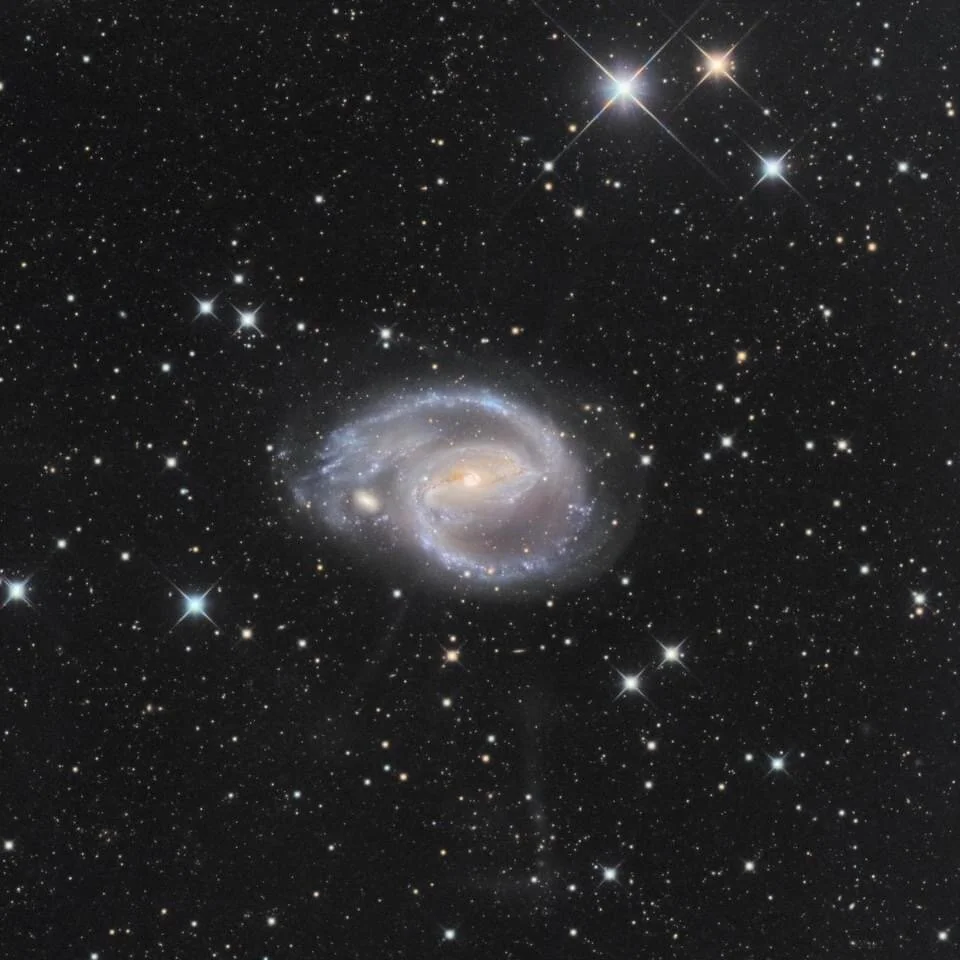
AAPOD2 Image Archives
Thor's Helmet
Image Description and Details :
Popularly called Thor's Helmet, NGC 2359 is a hat-shaped cosmic cloud with wing-like appendages. Heroically sized even for a Norse god, Thor's Helmet is about 30 light-years across. In fact, the cosmic head-covering is more like an interstellar bubble, blown with a fast wind from the bright, massive star near the bubble's center. Known as a Wolf-Rayet star, the central star is an extremely hot giant thought to be in a brief, pre-supernova stage of evolution. NGC 2359 is located about 15,000 light-years away toward the constellation of the Great Overdog. This remarkably sharp image is a mixed cocktail of data from broadband and narrowband filters, capturing not only natural looking stars but details of the nebula's filamentary structures. The star in the center of Thor's Helmet is expected to explode in a spectacular supernova sometime within the next few thousand years.
Location/Date – El Sauce, Chile
Imaging System – Planewave CDK17, FLI ML16803, Chroma HaO3RGB filters, 10 Micron GM3000
Exposure – HORGB, 27.5 hours
Copyright: Good Astronomy
The Grus Triplet
Image Description and Details : The Grus Triplet is group of galaxies about 60 million light years away in the constellation Grus and is comprised of NGC 7582, NGC 7590, and NGC 7599. These three galaxies along with NGC 7552 make up the Grus Quartet, which is part of the IC 1459 Group.
Location/Date – El Sauce, Chile, August 2021
Imaging System – Planewave 17” CDK, 10 Micron GM3000, FLI ML16803 Chroma Filters
Exposure – LRGB, 11 hours
Copyright: Good Astronomy
Ngc1097
Enigmatic spiral galaxy NGC 1097 lies about 45 million light-years away in the southern constellation Fornax. The small companion galaxy, just left of center, that seems to be wrapped in its spiral arms, is not NGC 1097's most peculiar feature though. Instead, This very deep exposure shows hints of faint, mysterious jets, most easily seen to extend well beyond the bright arms toward the bottom. In fact, four faint jets are ultimately recognized in optical images of NGC 1097. The jets trace an X centered on the galaxy's nucleus, but could be fossil trails left over from the capture of a much smaller galaxy in the large spiral's ancient past. A Seyfert galaxy, NGC 1097's nucleus also harbors a massive black hole.
Copyright Good Astronomy
NGC 1365
Barred spiral galaxy NGC 1365 is truly a majestic island universe some 200,000 light-years across. Located a mere 60 million light-years away toward the chemical constellation Fornax, NGC 1365 is a dominant member of the well-studied Fornax galaxy cluster. This impressively sharp color image shows intense star forming regions at the ends of the bar and along the spiral arms, and details of dust lanes cutting across the galaxy's bright core. At the core lies a supermassive black hole. Astronomers think NGC 1365's prominent bar plays a crucial role in the galaxy's evolution, drawing gas and dust into a star-forming maelstrom and ultimately feeding material into the central black hole.Location/Date – El Sauce, Chile, December 2020Imaging System – Planewave 17” CDK, 10 Micron GM3000, FLI ML16803 Chroma FiltersExposure – LRGB, 9 hoursProcessing – Pixinsight
Credit/Copyright – Casey Good / Good Astronomy
Cederblad 111 (Ced 111)
Cederblad 111 (Ced 111) is a blue reflection region in the southern constellation of Chamaeleon and is part of one of the closest (~550 light years) dark cloud complexes to the Sun. Ced 110 is the bright reflection in the lower portion of the image with the distinct bright arc. Both are part of Cha I dark cloud complex. The median age is estimated at ~2 Myr. The cloud complex is a stellar nursery and many new stars have been detected through their variability and H-a emission. The small, elongated, bright red objects at the center of the image are Hebrig-Haro objects (HH 49-50), which form from a collision between ionized jets of gas ejected from newly born stars and the surrounding cloud.
Imaging telescopes or lenses:Takahashi TOA-150
Imaging cameras:FLI ML16200
Mounts:Astro-Physics 1600 with Absolute Encoders
Filters: L , B , G , R
Integration: 16.7 hours
Copyright Good Astronomy





